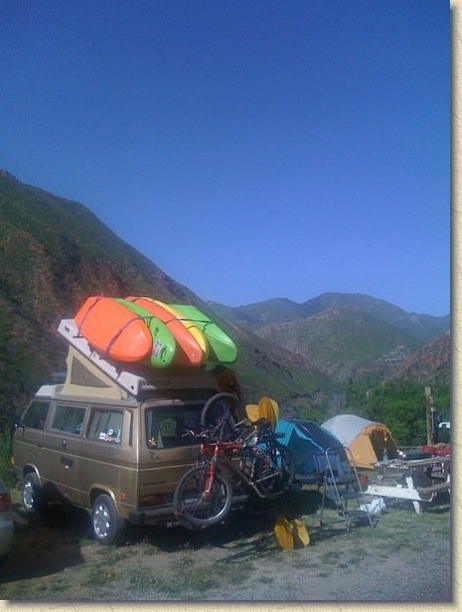12/3/10- 5:09am Barely got our kayaks onto the plane. "Continental Airlines will accept one pack containing a lightweight assembly kayak less than 50 lbs ". No size restrictions mentioned or any mention of hardshell vs. collapsible. We were second in line at 4am, but the agent said there was a luggage embargo for large items and that our kayaks didn't qualify as "kayak assembly". Not cool. Fortunately, I kept my cool and after 20 minutes, I was able to convince the supervisor to let the boats on the plane. Whew. Now I'm just hoping they make it to Costa Rica.
4:31pm Made it to San Jose and the Hotel Mi Tierra and sent my first SPOT update. Now I'm updating my blog from my iPhone over wifi in the hotel. Very cool use of technology! And just as importantly, our kayaks and gear all made it here successfully. Pura Vida!

12/4/10 7:00am The whole crew made it here and we are off to run the Sarapaqui and possibly a 30 foot waterfall! Bueno!

7:55pm Awesome day on the Lower Sarapaqui. Lyle was the only one to run the 30 ft waterfall, since he broke his paddle on the descent. The jungle setting and warm water were huge contrasts to my normal Colorado boating style and very cool. Exhausted.
12/5/10 8:41pm Another incredible day in the Sarapaqui. This time we did the Upper and Lower. I could really get used to boating every day down here. It doesn't get much better!
12/6/10 6:30pm Kayaked the Upper and Lower Pejibaye today. Very cool jungle setting with huge boulders and trees hanging over the river. Big 6' drop to start things out and then slow going to avoid strainers among the boulders. We all had a great time and are now staying in the beautiful Turrialtico lodge just outside of Turrialba. Tomorrow we begin an overnight on the Pacuare, so no internet but SPOT should hopefully work, and of course the kayaking and scenery will be incredible.

12/7/2010- 9am, Change of plans. It rained all night which resulted in the Pacaure swelling up to the red gauge. So rather than chance it, we are heading to the beach for a few days. Either way, it's hard to beat!
12/8/10 8:30am. Dawn patrol kayak surf session this morning at Playa Hermosa. Now off to kayak a river. Awesome!

6pm. Kayaked Upper and Lower Naranjo. Another cool run and even had a crocodile chase Lyle!
Now we are staying in Dominical beach town for a few days. The black sand beaches have amazing phosphorescent organisms that light up like stars when you kick sand in the dark- trippy!

12/9/10 6:30pm Just got out of my boat for the last time today. It's really amazing how much time I have spent in it this week! Today, we started kayaking in a tiny mountain creek that led into the clear waters of Rio Guabo that eventually led us into the Pacific Ocean. Source to sea- how incredible! Along the way, we had shelf drops, waterfalls, a poisonous snake, a crocodile, and then 6' breaking waves in the ocean. And then we surfed our way back along the beach to our hotel. After a short break, we were back in the ocean ripping up the waves in front of an amazing sunset! Finally, darkness got us out of our boats and back to the hotel for a shower and dinner. Man, what an incredible vacation!
12/10/10 6:30pm. Living the life in Costa Rica. In the ocean at 5am for 2 hours of kayak surfing as the sun rose, then kayaked the middle section of Rio General, then back in the ocean for the last hour and half of the day for more kayak surf as the sun set over the Pacific.
12/11/10 10pm. How many days can I report on another great day here in Costa Rica? Dunno, but today will be my last until my next visit :-( Today began with another dawn kayak surf session followed by banana pancakes and then kayaking the Rio Savagre. What an amazing trip!
Finally put together a photo slideshow and posted it to YouTube!

































